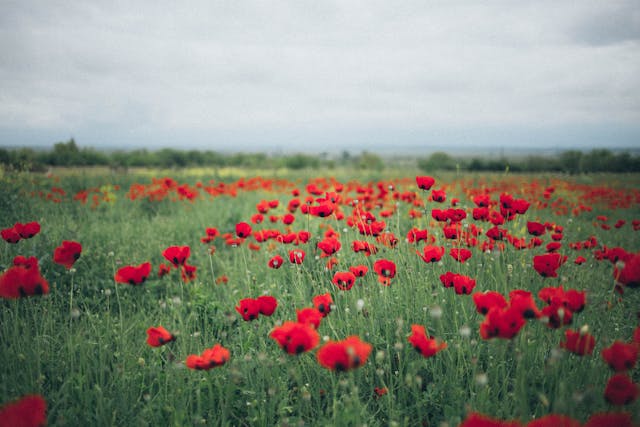
Why are poppies a symbol of remembrance? Because of a poem by a Canadian doctor called John McCrae. The poem was called “In Flanders Fields”. And because of an American professor and humanitarian called Moina Michael.
Before World War One, war dead were not really remembered, unless they were wealthy people. There were no memorials or plaques for them and most of the bodies were left on the battlefield where they died. Soldiers were not respected or thanked or even known about. World War One brought about several major changes to the way the war dead were remembered. So many people died that the governments involved realized that they needed to do something. They started trying to identify the bodies. The invention of dog tags helped, but quite often they were destroyed when people were blown up. Once bodies were identified they were buried in war cemeteries in Europe (Britain) or brought home for burial (America). National war memorials were built in the capitals of each country and smaller war memorials were built in any town that sent soldiers to die. Tombs of unknown soldiers were built in most of the countries that took part as well. The idea was that people whose loved ones were not identified could believe that it was their father, brother, or son who was entombed there. It brought some catharsis. After the war, remembrance services were held every year, and it became a tradition to wear poppies and to lay wreaths of poppies. So, why poppies?
Poppies were very common flowers on the battlefields of World War 1 and on other battlefields throughout history. Wild poppy seeds can lie dormant under the ground for years, waiting for conditions to be right. They prefer to have no other vegetation for competition, and they need the soil to be dug up to release all of the nutrients. In the battlefields of World War 1, there was no other vegetation because it had all been destroyed by artillery barrages. The soil had also been freshly dug up by these barrages as well, bringing the poppy seeds close to the surface. They didn’t need much encouragement and they grew very quickly. There is also a theory that the poppies were helped by all of the lime from destroyed buildings that entered the soil. This would have minerally enriched the soil. Some people said red flowers were growing because of the blood that had been spilled on the soil, but on other battlefields, white poppies had grown. The poppy that grew on the battlefields of Europe was Papaver rhoeas, which is a Mediterranean wildflower, and actually classed as a weed, which is why it was able to grow so prolifically.
On a darker note, when the soil was dug up by the artillery, it released buried bacteria called Clostridium perfringens that could easily get into wounds when soldiers were in trenches, or when they were hit with shrapnel that had soil on it. Their uniforms would have bacteria as well and if they were injured, the projectile could carry pieces of uniform into the wound. There were no antibiotics at that time and bacterial research was in its infancy. Many died or lost limbs because of the same soil turnover that brought out the poppies.
The poppies became a symbol of the war back home as well because of a poem by John McCrae. He was a Canadian doctor, and he was taking a short rest from tending the wounded. Being a war doctor was a terrible profession. From where he was sitting he could see a cemetery and he wrote a poem, which he called In Flanders Field. Here is the poem.
In Flanders fields the poppies blow
Between the crosses, row on row,
That mark our place; and in the sky
The larks, still bravely singing, fly
Scarce heard amid the guns below.
We are the Dead. Short days ago
We lived, felt dawn, saw sunset glow,
Loved and were loved, and now we lie,
In Flanders fields.
Take up our quarrel with the foe:
To you from failing hands we throw
The torch; be yours to hold it high.
If ye break faith with us who die
We shall not sleep, though poppies grow
In Flanders fields.
The poem was published in Punch magazine on December 8, 1915. It became a very popular poem and was often used at memorial ceremonies during the war. McCrae sadly died in 1918. Just before the First World War ended, an American humanitarian called Moina Michaels read the poem. She made a red poppy out of fabric and vowed to wear it all the time. After the war she taught at university, and she had a class of disabled servicemen. She realized that the people coming back from the war needed financial help and she had the idea of selling the poppies she had made to raise money to help them. She started a campaign, and it took several years, but by 1921 the American Legion and the British Legion had both adopted the poppy as the symbol of war veterans and of remembrance. She became known as the poppy lady. And this is what I learned today.
Photo by Elina Sazonova: https://www.pexels.com/photo/red-poppy-flower-field-1876620/
Sources
https://www.iwm.org.uk/history/why-we-wear-poppies-on-remembrance-day
https://www.legion.org/poppyday/history
https://en.wikipedia.org/wiki/Tomb_of_the_Unknown_Soldier
https://en.wikipedia.org/wiki/Remembrance_Day
https://www.history.com/news/world-war-i-poppy-remembrance-symbol-veterans-day
https://en.wikipedia.org/wiki/Moina_Michael
https://www.poetryfoundation.org/poems/47380/in-flanders-fields
